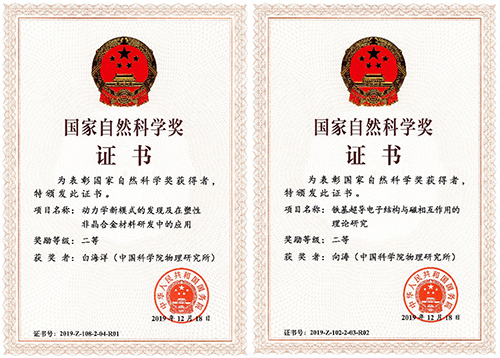Two IOP Achievements Win the Second Prize of 2019 National Natural Science Award
Date:10-01-2020 Print
The National Science and Technology Award Conference was held in the Great Hall of the People in Beijing on January 10. Two achievements made by the Institute of Physics (IOP) of the Chinese Academy of Sciences (CAS) won the second prize of 2019 National Natural Science Award, including "discovery of a new model in dynamics and its application in the research and development of plastic amorphous alloy materials" and the cooperative achievement with Renmin University of China, "theoretical study on the interaction of iron-based superconducting electronic structures and magnetism".

The achievement of "discovery of a new model in dynamics and its application in the research and development of plastic amorphous alloy materials" won the second prize of 2019 National Natural Science Award. Prizewinners are Bai Haiyang (IOP), Wen Ping (IOP), Sun Baoan (IOP), Liu Yanhui (IOP) and Wang Weihua (IOP).
After more than ten years of research, the group has found an important dynamic relaxation model, namely β-relaxation model, in the dynamics of amorphous alloys; proposed the origin and mechanism of the microstructure of the relaxation, and then established the correlation between the dynamic relaxation model and the mechanical behavior of amorphous alloys; developed a series of amorphous alloy materials with high plasticity at room temperature and tensile plasticity near room temperature, based on the correlation between dynamics and mechanical properties. The achievement not only contributes to controlling and designing the macro-mechanical properties of amorphous alloy materials, but also provides a theoretical basis and a new idea for the development of high-performance amorphous alloy materials.
The achievement "theoretical study on the interaction of iron-based superconducting electronic structures and magnetism" won the second prize of 2019 National Natural Science Award. Prizewinners are Lu Zhongyi (Renmin University of China), Xiang Tao (IOP), Ma Fengjie (Institute of Theoretical Physics, CAS), Yan Xunwang (Institute of Theoretical Physics, CAS) and Gao Miao (Renmin University of China).
Iron-based superconductivity is an important research direction in condensed matter physics and is of great significance in exploring the mechanism of unconventional high-temperature superconductivity. The group first discovered and predicted that the iron-based superconducting matrix was an antiferromagnetic semimetal, and pointed out that the antiferromagnetic superexchange transmitted by arsenic or selenium was the main magnetic interaction and the main cause of superconducting electron pairing. Based on that, they successfully predicted two new magnetic ordering structures of iron-based superconductivity. These findings have revealed the microscopic origin of magnetic interactions, thus deepening the understanding of the basic properties of iron-based superconductivity, and contributing to the development of this field.

